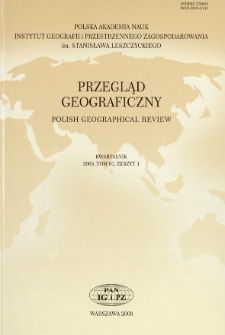- Wyszukaj w całym Repozytorium
- Piśmiennictwo i mapy
- Archeologia
- Baza Młynów
- Nauki przyrodnicze
Wyszukiwanie zaawansowane
Wyszukiwanie zaawansowane
Wyszukiwanie zaawansowane
Wyszukiwanie zaawansowane
Wyszukiwanie zaawansowane

Obiekt
Tytuł: Opady frontowe na polskim wybrzeżu Bałtyku = Frontal precipitation along the Polish coast
Inny tytuł:
Przegląd Geograficzny T. 81 z. 1 (2009)
Wydawca:
Miejsce wydania:
Opis:
Typ obiektu:
Abstrakt:
Na podstawie dolnych map synoptycznych z lat 1998–2003 wykonano analizę opadów atmosferycznych w obrębie poszczególnych typów frontów atmosferycznych. Wysnuto następujące wnioski dotyczące obszaru polskiego wybrzeża Bałtyku: największe średnie sumy opadów formują się w obrębie frontów zokludowanych, aczkolwiek najwyższe maksymalne sumy opadów towarzyszą frontom chłodnym (pojedyncze bardzo wysokie sumy opadów zdarzają się również w półroczu ciepłym w jednorodnych masach powietrza); wpływ frontów chłodnych na opady jest większy w sezonie ciepłym niż w chłodnym, zaś oddziaływanie frontów ciepłych większe jest w sezonie chłodnym.
Bibliografia:
1. Bogucka M., 1997, Ekstremalne opady atmosferyczne w Polsce w przedziałach 6-godzinnych i ich związek z sytuacją synoptyczną, [w:] Materiały Sympozjum Jubileuszowego Polskiego Towarzystwa Geofizycznego Ekstremalne zjawiska meteorologiczne, hydrologiczne i oceanograficzne", Warszawa 12–14 XI 1997, IMGW, Warszawa, s. 22–25.
2. Malinowska M., 2003, Sytuacje synoptyczne w Polsce Północnej a opady na Żuławach Wiślanych, Badania Fizjograficzne nad Polską Zachodnią, Seria A: Geografia Fizyczna, 54, s. 113–130.
3. Malinowska M., 2006, Makroskalowe uwarunkowania opadu atmosferycznego na Żuławach Wiślanych, Wiadomości IMGW, 1, s. 25–48.
4. Miętus M., Filipiak J., 2002, Struktura czasowo-przestrzennej zmienności warunków opadowych w rejonie Zatoki Gdańskiej, Materiały Badawcze IMGW, Seria: Meteorologia, 34.
5. Miętus M., Filipiak J., Owczarek M., 2003, Czasowo-przestrzenna struktura opadów w rejonie Zatoki Gdańskiej i jej możliwe zmiany w skali XXI wieku, [w:] J. Cyberski (red.), Powódź w Gdańsku 2001, Gdańskie Towarzystwo Naukowe, Gdańsk, s. 35–56.
6. Parczewski W., 1965, Fronty atmosferyczne nad Polską, Wiadomości Służby Hydrologicznej i Meteorologicznej, 59, 4, s. 20–36.
7. Twardosz R., 2005, Dobowy przebieg opadów atmosferycznych w ujęciu synoptycznym i probabilistycznym na przykładzie Krakowa (1886–2002), Instytut Geografii i Gospodarki Przestrzennej UJ, Kraków.
8. Walther A., Bennartz R., 2006, Radar-based precipitation type analysis in the Baltic area, Tellus, 58 A, s. 331–343.
9. Warakomski W., 1974, Zachmurzenie wewnątrzmasowe w Polsce, Annales UMCS, sec. B, 29, 4, s. 77–105.
10. www.wetterzentrale.de/topkarten
Czasopismo/Seria/cykl:
Tom:
Zeszyt:
Strona pocz.:
Strona końc.:
Szczegółowy typ zasobu:
Format:
Rozmiar pliku 0,1 MB ; application/pdf
Identyfikator zasobu:
oai:rcin.org.pl:55624 ; 0033-2143 ; 10.7163/PrzG.2009.4.5
Źródło:
CBGiOŚ. IGiPZ PAN, sygn.: Cz.181, Cz.3136, Cz.4187 ; kliknij tutaj, żeby przejść
Język:
Język streszczenia:
Prawa:
Prawa zastrzeżone - dostęp nieograniczony
Zasady wykorzystania:
Digitalizacja:
Instytut Geografii i Przestrzennego Zagospodarowania Polskiej Akademii Nauk
Lokalizacja oryginału:
Dofinansowane ze środków:
Program Operacyjny Innowacyjna Gospodarka, lata 2010-2014, Priorytet 2. Infrastruktura strefy B + R ; Unia Europejska. Europejski Fundusz Rozwoju Regionalnego
Dostęp:
Kolekcje, do których przypisany jest obiekt:
- Repozytorium Cyfrowe Instytutów Naukowych > Kolekcje Partnerów > Instytut Geografii i Przestrzennego Zagospodarowania PAN > Publikacje pracowników i Wydawnictw
- Repozytorium Cyfrowe Instytutów Naukowych > Kolekcje Partnerów > Instytut Geografii i Przestrzennego Zagospodarowania PAN > Biblioteka Instytutu > Serie/Czasopisma/Cykle
- Repozytorium Cyfrowe Instytutów Naukowych > Piśmiennictwo > Czasopisma/Artykuły
Data ostatniej modyfikacji:
25 mar 2022
Data dodania obiektu:
29 lip 2015
Liczba pobrań / odtworzeń:
1043
Wszystkie dostępne wersje tego obiektu:
https://rcin.org.pl./publication/75240
Wyświetl opis w formacie RDF:
Wyświetl opis w formacie RDFa:
Wyświetl opis w formacie OAI-PMH:
| Nazwa wydania | Data |
|---|---|
| Świątek M. - Opady frontowe na polskim wybrzeżu Bałtyku = Frontal precipitation along the Polish coast | 25 mar 2022 |
Obiekty Podobne
Świątek, Małgorzata
Szelęgiewicz, Henryk (1927–1983)
Orłowicz, Mieczysław (1881–1959)

 INSTYTUT ARCHEOLOGII I ETNOLOGII POLSKIEJ AKADEMII NAUK
INSTYTUT ARCHEOLOGII I ETNOLOGII POLSKIEJ AKADEMII NAUK
 INSTYTUT BADAŃ LITERACKICH POLSKIEJ AKADEMII NAUK
INSTYTUT BADAŃ LITERACKICH POLSKIEJ AKADEMII NAUK
 INSTYTUT BADAWCZY LEŚNICTWA
INSTYTUT BADAWCZY LEŚNICTWA
 INSTYTUT BIOLOGII DOŚWIADCZALNEJ IM. MARCELEGO NENCKIEGO POLSKIEJ AKADEMII NAUK
INSTYTUT BIOLOGII DOŚWIADCZALNEJ IM. MARCELEGO NENCKIEGO POLSKIEJ AKADEMII NAUK
 INSTYTUT BIOLOGII SSAKÓW POLSKIEJ AKADEMII NAUK
INSTYTUT BIOLOGII SSAKÓW POLSKIEJ AKADEMII NAUK
 INSTYTUT CHEMII FIZYCZNEJ PAN
INSTYTUT CHEMII FIZYCZNEJ PAN
 INSTYTUT CHEMII ORGANICZNEJ PAN
INSTYTUT CHEMII ORGANICZNEJ PAN
 INSTYTUT FILOZOFII I SOCJOLOGII PAN
INSTYTUT FILOZOFII I SOCJOLOGII PAN
 INSTYTUT GEOGRAFII I PRZESTRZENNEGO ZAGOSPODAROWANIA PAN
INSTYTUT GEOGRAFII I PRZESTRZENNEGO ZAGOSPODAROWANIA PAN
 INSTYTUT HISTORII im. TADEUSZA MANTEUFFLA POLSKIEJ AKADEMII NAUK
INSTYTUT HISTORII im. TADEUSZA MANTEUFFLA POLSKIEJ AKADEMII NAUK
 INSTYTUT JĘZYKA POLSKIEGO POLSKIEJ AKADEMII NAUK
INSTYTUT JĘZYKA POLSKIEGO POLSKIEJ AKADEMII NAUK
 INSTYTUT MATEMATYCZNY PAN
INSTYTUT MATEMATYCZNY PAN
 INSTYTUT MEDYCYNY DOŚWIADCZALNEJ I KLINICZNEJ IM.MIROSŁAWA MOSSAKOWSKIEGO POLSKIEJ AKADEMII NAUK
INSTYTUT MEDYCYNY DOŚWIADCZALNEJ I KLINICZNEJ IM.MIROSŁAWA MOSSAKOWSKIEGO POLSKIEJ AKADEMII NAUK
 INSTYTUT PODSTAWOWYCH PROBLEMÓW TECHNIKI PAN
INSTYTUT PODSTAWOWYCH PROBLEMÓW TECHNIKI PAN
 INSTYTUT SLAWISTYKI PAN
INSTYTUT SLAWISTYKI PAN
 SIEĆ BADAWCZA ŁUKASIEWICZ - INSTYTUT TECHNOLOGII MATERIAŁÓW ELEKTRONICZNYCH
SIEĆ BADAWCZA ŁUKASIEWICZ - INSTYTUT TECHNOLOGII MATERIAŁÓW ELEKTRONICZNYCH
 MUZEUM I INSTYTUT ZOOLOGII POLSKIEJ AKADEMII NAUK
MUZEUM I INSTYTUT ZOOLOGII POLSKIEJ AKADEMII NAUK
 INSTYTUT BADAŃ SYSTEMOWYCH PAN
INSTYTUT BADAŃ SYSTEMOWYCH PAN
 INSTYTUT BOTANIKI IM. WŁADYSŁAWA SZAFERA POLSKIEJ AKADEMII NAUK
INSTYTUT BOTANIKI IM. WŁADYSŁAWA SZAFERA POLSKIEJ AKADEMII NAUK




































